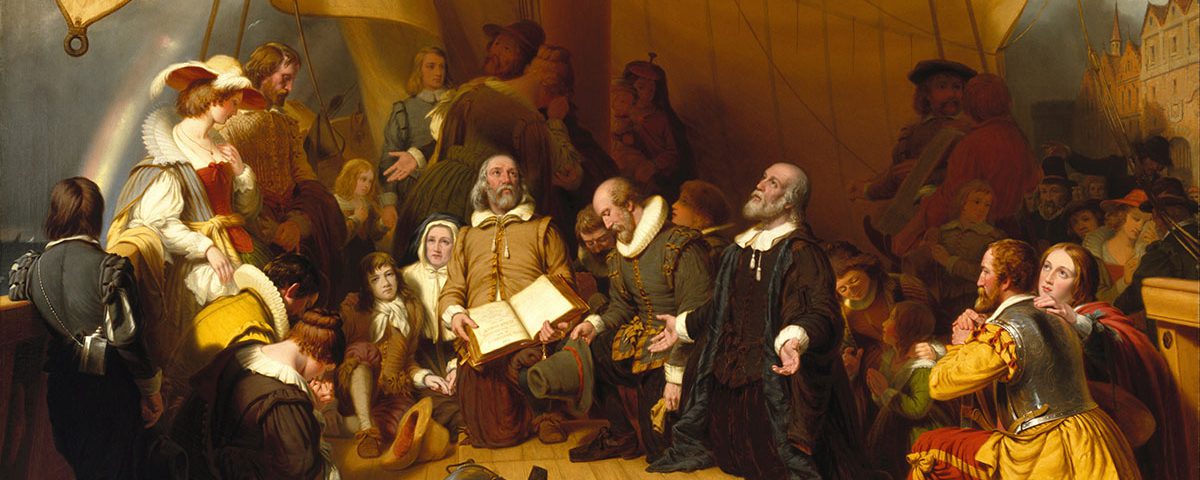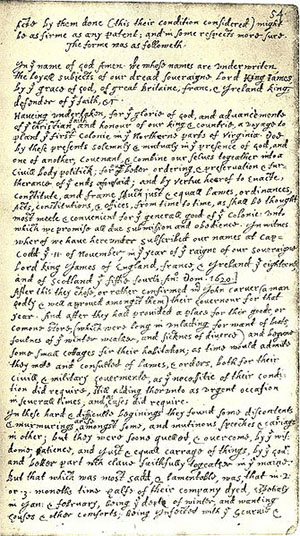As we near Thanksgiving, let’s take a moment to stop imagining the glorious feast that awaits us on November 24th to contemplate another juicy topic: insurance. Hopefully I haven’t already lost you. A word of caution: what I’m serving up below will require that you, dear reader, have a generous helping of suspension of disbelief. I hope this article will strike a unique part of your palate, somewhere between entertaining and educational. Get out your napkins, folks, because it’s about to get messy: let’s pick through the leftovers of November, 1620, to see if we can apply modern insurance coverage to the folks that landed at Plymouth Rock.
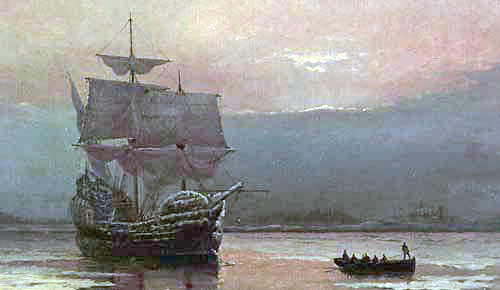
Boat Insurance
Once upon a time, there was a boat named Swiftsure, and it was used to fight against the Spanish Armada. After being decommissioned in 1605, it was renamed Speedwell and the pilgrims eventually purchased it. Speedwell was the sister ship of the famed Mayflower and was meant to accompany her on the journey to North America.
 |
First, the Speedwell transported some of the pilgrims from Delfshaven (located in the Netherlands) to Southampton, England. There the Speedwell met up with the Mayflower, and after completing final preparations for the long journey ahead, they departed for the New World together.
However, soon after departing, the Speedwell began taking on water and both Speedwell and the Mayflower diverted to Dartmouth, England. The Speedwell was inspected for leaks and despite sealing them, a second attempt to depart also failed. Deciding that the Speedwell was not sea-worthy, the ship was sold and some (not all) of the crew and passengers were transferred to the Mayflower for the long journey ahead.
|
To keep it simple: if the pilgrims had purchased a modern boat insurance policy, they could have been covered for the damage causing the leaks on their ship, injuries to their passengers, and the gear they’d packed. If this coverage had been in place and they’d gotten the necessary repairs done in a satisfactory manner this could have changed history in an interesting way; instead of only the Mayflower landing at Plymouth Rock, the Speedwell and her original compliment could have landed as well.
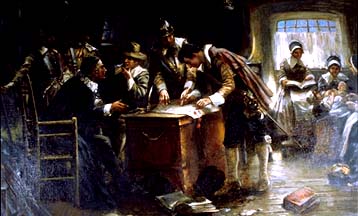
Condo Insurance
Hah! How’d you like that curve ball? You must be thinking, “Condo insurance? The pilgrims didn’t live in condos! You may be an amazing storyteller, but you’re also insane!” Okay, maybe not that last part, but hear me out.
|
|
The pilgrims, upon reaching the New World, drafted what is perceived by some as the world’s first written constitution: the Mayflower Compact. The Mayflower Compact would promise cooperation among the settlers, allowing them to vote on important issues. It was a social contract, to which the pilgrims agreed for the sake of order within their community, as well as for their very survival. John Carver is credited with penning the Mayflower Compact, and he was also chosen as the colony’s first governor.
As the pilgrims established their colony, they built houses, farms, and other structures. They shared these houses and depended on them as a community. At one point, all single men were ordered to join one of the nineteen existing families in order to eliminate the need to build more homes than was necessary. It was in everyone’s best interest that these houses and farms were well maintained. Each individual would have had a great personal interest in all of these structures. Even if they only lived and worked in one particular building, all of the buildings were vital; their survival depended upon them. |
Here’s where we make the jump over to condo insurance: a condo association represents the members of a condo complex and is headed up by a board of directors. This board is elected to represent the condominium owners and makes decisions on their behalf. Some of the responsibilities of the board include protecting the condo association from financial loss due to damage to structures and protecting the unit owners from liability related issues like injuries occurring on their property. The condo association members pay membership fees to contribute to these policies. It’s in everyone’s best interest to cover one another; otherwise, everyone within the association would be liable for the damages to one of the structures, or everyone could wind up being liable for an injury occurring on one of the properties.
So, in much the same way condo associations operate today (with decidedly less emphasis on pure survival, granted), everyone in the colony had a vested interest in all of the structures, and would have contributed to their well being and upkeep.
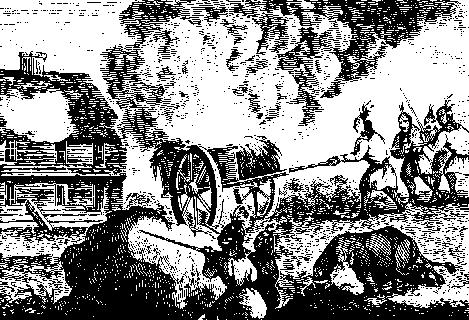
Life Insurance
Alright, I’ll admit, this one is a little dark, but to put it bluntly: it’s something that everyone should take a moment to consider for themselves. The pilgrims had endured an ocean crossing in miserable conditions. Some contracted scurvy during the journey and, by December, most of the passengers and crew had become ill. In fact, the very first structure they built was converted into a hospital. Not only that, they had several skirmishes with the Native Americans who had inhabited the land for hundreds of years prior to the pilgrims’ arrival. Of the 102 original pilgrims that departed England in September of 1620, only 47 had survived to March of 1621. In this same time period, half of the Mayflower’s crew also perished. Suffice to say: life for the pilgrims was hard, dangerous and, unfortunately for many, short. A life insurance policy could have helped protect their grieving family from financial hardship.
Kidnapping and Ransom Insurance
The tale I’m about to present to you is a scandalous story full of unsavory characters, with the worst part being that it’s actually true. This story involves four siblings, the More children, who had sailed on the Mayflower. For years, historians speculated as to why these children were on the Mayflower, as they had no other relatives aboard the ship. In 1959, historians found their answer in a dusty attic where they uncovered a court statement penned in 1622. Welcome to the dark side of the Mayflower.
Samuel More, the son of Richard More, master of Linley estate, was working in London as secretary to Lord Edward Zouche. Lord Zouche was a pretty important guy who held the titles of Lord President of the Council of Wales, Lord Warden of the Cinque Ports and Privy Counselor. Over the course of four years Samuel’s wife, Katherine, had four children: Ellinor, Jasper, Mary, and Richard.
In 1616, Samuel accused his wife Katherine of adultery and stated that the children weren’t his, but belonged to a neighbor, Jacob Blakeway. Surprisingly, Jacob and Katherine never denied the affair, citing a prior betrothal as the reason for the infidelity. In those days a betrothal was actually recognized by law as a contract to marry. This betrothal would have rendered her marriage to Samuel invalid; however, it also required two witness statements. Unfortunately for Katherine, all likely witnesses to her betrothal to Jacob Blakeway were dead.
In 1616 Samuel More, under his father Richard’s direction, removed the children from his home and placed them in the care of some of Richard More’s tenants in Linley. According to Samuel, during this time, Katherine went to Linley and engaged in a struggle to take her children back. The More children would remain at Linley for the next four years.
During this time, Samuel went to his employer and family friend, Lord Zouche, to draw up a plan for the More children. Lord Zouche had previously invested in expeditions to the New World, specifically the expeditions to the Colony of Virginia (which is where the Mayflower was supposed to have made landfall).
From 1616 onward, Katherine made several attempts to reclaim her children by petitioning the court. Her final attempt came in 1622. Samuel issued a statement to the court explaining that he had, two years prior and without Katherine’s knowledge or consent, sent the children away. He had the children delivered to John Carver (yes, the same John Carver I mentioned above as writing the Mayflower Compact) and Robert Cushman, who were both bound for North America aboard the Mayflower. The children had been taken aboard as indentured servants. Keep in mind, Samuel’s statement was made in court in 1622. The Mayflower had already set sail from England in 1620. Katherine’s children had been gone for nearly two years. Samuel’s reasoning for sending the children away was due to the “great grief of such a spurious brood,” and he had sent them to America in order to “provide for the education and maintenance of these children in a place remote from these parts where these great blotts and blemishes may fall upon them.”
The More children survived the journey across the Atlantic. Tragically, however, Elinor, 8 years of age, Jasper, 7, and Mary, 4, perished in the New World during the first winter. However, six year old Richard More survived and went on to become a well known sea captain who delivered vital supplies to various colonies, aiding in their survival. All records of Katherine are lost past 1622, and it’s unknown if Richard More ever reunited with his mother.
You may not have ever heard of Kidnapping and Ransom Insurance. To be honest, I hadn’t heard of it when I started this article. But you can see where it could have come into play during this tragic tale, and it’s something to consider if kidnapping/ransom is legitimate concern for you and your family.
Further Reading
I hope you’ve enjoyed our little jaunt through history and had a little fun in the process. If I’ve piqued your interest in the pilgrims’ story or (gasp) insurance, I suggest you take a look at the links below! Happy Thanksgiving!
- Wikipedia: Pilgrim Fathers
- Wikipedia: Plymouth Colony
- Boat Insurance: Al Bourdeau Insurance Agency’s Boat Insurance Site
- Condo Insurance: Al Bourdeau’s “Your Home” section (click on the “Condo” link)
- Life Insurance: Al Bourdeau’s “Your Health” section (click on the “Life” link)
- Kidnapping and Ransom Insurance: Wikipedia Article
Darin Mohrman
I’m a former aspiring “ski-bum” turned insurance professional.I was licensed in 2002 and in 2013 I obtained my Certified Insurance Counselor (C.I.C.) designation. I'm married to an amazing woman, have a wonderful son and a cat.I enjoy travelling, music, craft beer, woodworking, collecting and restoring antique tools and all things computer and tech related.
Latest posts by Darin Mohrman (see all)
- Skip the “Snail Mail” - February 17, 2021
- Your Waterfront Home May Not Be Adequately Insured - February 12, 2021
- Citizens Insurance SafeTeen Program - February 9, 2021

